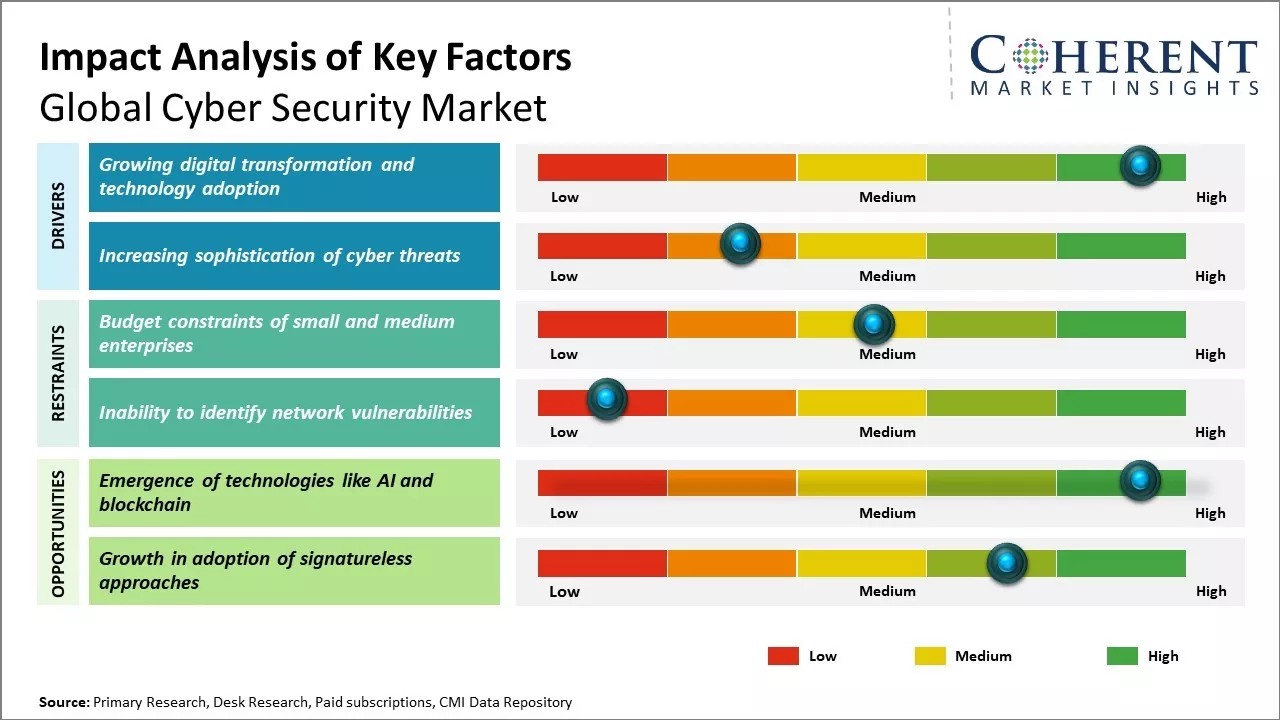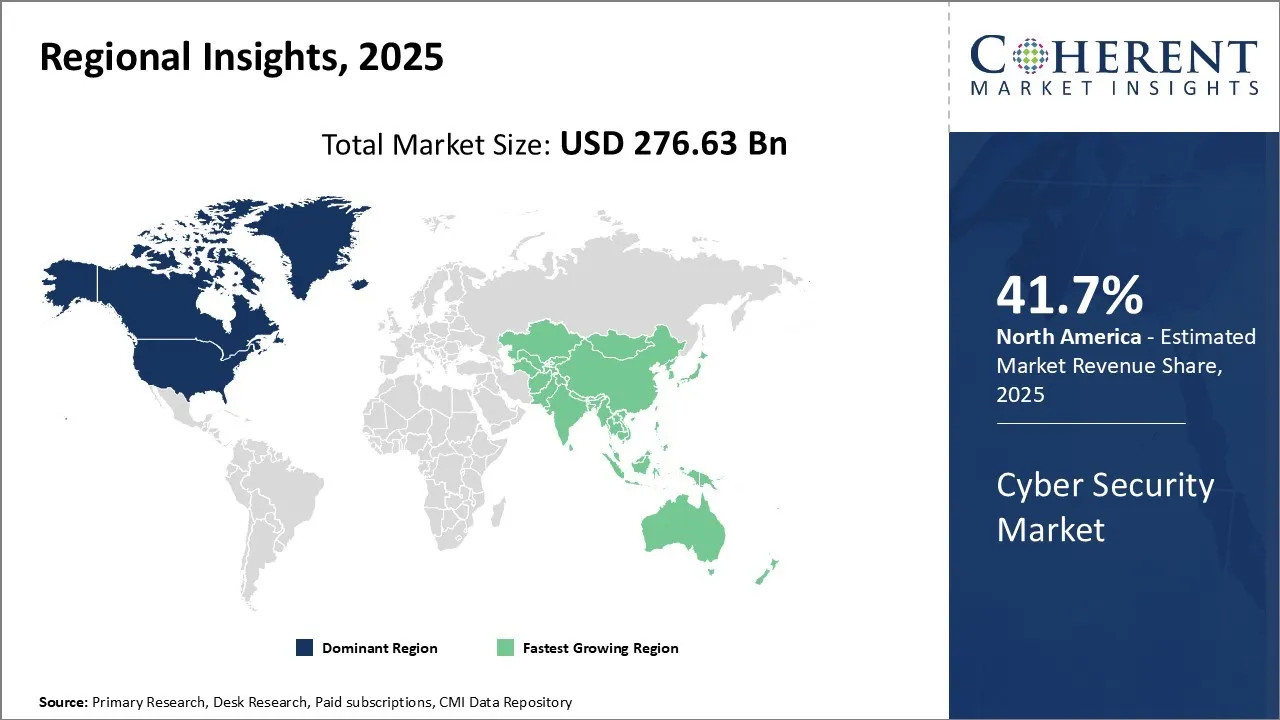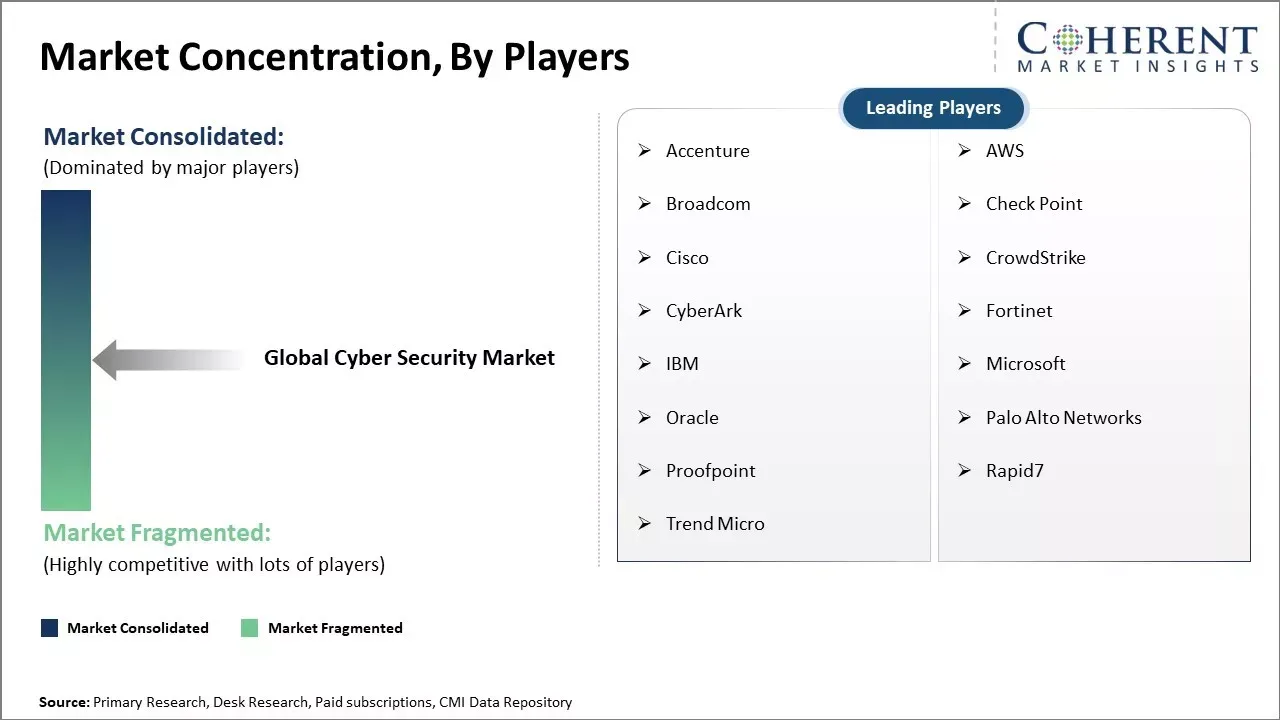The Global Cyber Security Market is estimated to be valued at USD 276.63 Bn in 2025 and is expected to reach USD 631.30 Bn by 2032, exhibiting a compound annual growth rate (CAGR) of 12.5% from 2025 to 2032.

To learn more about this report, Download Free Sample
Cyber security threats are growing rapidly as more individuals and organizations get connected to the internet leading to rising wave of cyber-attacks worldwide. The need to secure personal and sensitive data from malicious actors has never been more important. This has compelled more businesses and government to bolster their security measures by upgrading systems and adopting advanced solutions, which is expected to drive continued healthy growth of the cyber security market during the forecast period.
|
Current Event |
Description and its Impact |
|
European Union Digital Sovereignty and Regulatory Expansion |
|
|
Artificial Intelligence Security Arms Race and Emerging Threats |
|
Uncover macros and micros vetted on 75+ parameters: Get instant access to report
|
Metric |
Insight |
|
Global Cybercrime Costs |
Projected to reach $10.5 trillion annually in 2025 |
|
Daily Cyberattacks |
Over 2,200 attacks per day worldwide (one every 39 seconds) |
|
Ransomware Share |
Accounts for 68% of all detected threats, with 1.7 million hits daily |
|
Phishing Scale |
Around 3.4 billion malicious emails sent daily |
|
Sector Impact |
Education faces 3,000+ attacks weekly; healthcare and finance heavily targeted |
|
Global Spending |
Cybersecurity spending projected to exceed $212 billion in 2025 (+15% YoY) |
|
Workforce Gap |
Millions of skilled professionals still needed worldwide |
|
Regional Leaders |
U.S., China, UK, Germany, Japan, Australia driving adoption |
Uncover macros and micros vetted on 75+ parameters: Get instant access to report
In terms of component, the services segment contribute the 53.8% share of the global cyber security market in 2025 owing to the critical need for ongoing support. While foundational hardware and software protections are essential, the complex and constantly evolving threat landscape requires defensive measures to be continuously updated and enhanced. Maintaining advanced security infrastructure demands deep technical expertise that most organizations lack in-house on a permanent basis. Outsourcing to expert providers allows companies across sectors to access high-level skills and tailored solutions.
For instance, in November 2025, The Cyber Security Education and Awareness Project's MeitY Secretary started the Cyber Security Innovation Challenge 1.0 in New Delhi. The initiative encourages startups, students, and professionals to come up with new ideas, learn more about cyber security, and improve their skills. It also encourages them to come up with ways to make India's digital defenses stronger against new cyber threats.
In terms of deployment, the cloud-based solutions segment contribute the 63.6% share of the global cyber security market in 2025 because they deliver compelling advantages over on-premises options. Traditional software required substantial upfront capital expenditures for licenses, ongoing maintenance, and costly server infrastructure. These barriers limited access for many organizations. Cloud platforms eliminate such hurdles by offering services on a flexible, pay-as-you-go subscription basis optimized for scalability. Customers need not worry about hardware expenses or ongoing system management, significantly lowering the total cost of ownership.
For instance, in December 2025, Elastic and CISA started a cloud-based SIEM-as-a-Service to improve cybersecurity in all U.S. federal agencies. The solution improves digital defenses by providing scalable, real-time threat detection and log management. Elastic's technology and CISA's oversight work together in this partnership to make government systems more resilient, make monitoring easier, and protect them from new cyber threats.
In terms of application, the defense/government segment contributes the 36.1% share of the global cyber security market in 2025 due to high-profile networks housing classified national security data. Traditional commercial solutions cannot be deployed for government systems, as they lack stringent controls for vetting developers, reviewing code, and ensuring no external or unapproved parties may access underlying infrastructure or information. Government systems demand "air-gapped" protections developed specifically for separation and isolation from public networks to guard sensitive data.
For instance, in December 2025, India ordered phone makers to put a government cyber safety app on all new phones. The goal of the move is to improve national digital security, keep people safe from online threats, and make sure that rules are followed. The government makes the country's growing digital ecosystem safer by requiring built-in protection. This makes it more resilient and safer to use mobile devices.

To learn more about this report, Download Free Sample
North America has dominated the global cyber security market for many years owing to large technology companies and government investments in this space with 41.7% share in 2025. The presence of leading cyber security vendors and solution providers in the U.S. has cemented North America's position as the leader in this industry. Countries like the U.S. have also implemented stringent data protection and privacy laws that require businesses to beef up their cyber defenses.
As a result, enterprises across all industries spend heavily on cyber security products and services to safeguard their IT infrastructure and comply with regulations. The demand from both private and public sectors has enabled North American cyber security firms to continually enhance their solutions offerings. The region also benefits from a high level of digitization and an engaged customer base that is aware about latest threats.
For instance, in December 2025, Shift5 has been recognized as North America's Technology Innovation Leader in onboard operational technology platforms. The company makes aviation, rail, and defense safer from cyber-attacks by keeping an eye on and protecting important data streams. This achievement shows how important it is for protecting infrastructure and making businesses more resilient to new digital threats in all industries.
The Asia Pacific region has emerged as the fastest growing market for cyber security in recent times. Rapid digitization and increasing internet penetration in major economies like China and India have correspondingly increased the risk of cyberattacks. There is a growing emphasis on IT infrastructure across industries from finance to manufacturing to energy as these markets digitalize their operations.
Both private companies and government organizations recognize cyber security as a strategic priority in this evolving threat landscape. While the awareness is lower than developed markets. The presence of global R&D centers has also resulted in significant imports of advanced security solutions into the region. The pricing of these solutions is becoming more competitive with the rise of local APAC vendors. This favorable regulatory support combined with an immense market potential has made Asia Pacific the most dynamic cyber security market globally.
For instance, in August 2025, Accenture announced it would acquire CyberCX, which will improve its cybersecurity skills across the Asia-Pacific region. The purchase makes Accenture's threat intelligence, incident response, and managed security services stronger. This strategic move makes businesses and governments more resilient against rising cyber threats and strengthens Accenture's position as the world leader in advanced cybersecurity solutions.
The U.S. cybersecurity market is expected to be in high demand in 2025 because of rising costs of cybercrime, stricter rules, and the use of cloud, AI, and IoT technologies. Zero trust frameworks, threat intelligence, and resilience are very important to federal agencies and businesses. Ransomware attacks, supply chain risks, and a lack of skilled workers are all making people want to invest more in advanced security solutions.
For instance, in November 2025, Xerox and Palo Alto Networks worked together to create a single cybersecurity solution for small and medium-sized businesses in North America. The product provides enterprise-level security with easy management, which helps small and medium-sized businesses protect themselves from new cyber threats. This project adds to Xerox's offerings and makes businesses in the area more digitally resilient as they grow.
China's cybersecurity market is projected to expand in 2025 due to stricter rules, changes to its Cybersecurity Law, and more threats from the government. Vulnerabilities grow as digitalization, cloud adoption, and the growth of critical infrastructure happen promptly. Government oversight and compliance requirements force businesses to spend considerable amounts of money, which makes the country more resilient to new cyber threats.
For instance, in October 2025, China changed its Cybersecurity Law. The update makes rules for following the law stronger, protects data better, and makes rules for network security stronger. This change shows that China is serious about making its cyber defenses stronger, regulating digital ecosystems, and dealing with new cyber threats by having the government keep a closer eye on things.
| Report Coverage | Details | ||
|---|---|---|---|
| Base Year: | 2024 | Market Size in 2025: | USD 276.63 Bn |
| Historical Data for: | 2020 To 2024 | Forecast Period: | 2025 To 2032 |
| Forecast Period 2025 to 2032 CAGR: | 12.5% | 2032 Value Projection: | USD 631.30 Bn |
| Geographies covered: |
|
||
| Segments covered: |
|
||
| Companies covered: |
Accenture, AWS, Broadcom, Check Point, Cisco, CrowdStrike, CyberArk, Fortinet, IBM, Microsoft, Oracle, Palo Alto Networks, Proofpoint, Rapid7, Trend Micro |
||
| Growth Drivers: |
|
||
| Restraints & Challenges: |
|
||
Uncover macros and micros vetted on 75+ parameters: Get instant access to report
With the rapid pace of digital transformation and technology adoption across all industries globally, the risk of cyber threats and security breaches has significantly increased. Almost all business processes today are technology-enabled or completely dependent on various digital systems and networks. From large enterprises to small businesses, organizations are relying on Internet of Things (IoT) devices, cloud computing platforms, mobile technologies, and other digital infrastructures to improve efficiencies, drive innovation, and gain competitive advantages. However, the widespread deployment of connected devices and migration of workloads to public clouds have also enlarged the attack surface for cybercriminals.
For instance, in September 2023, the eHealth Centre of Excellence (eCE) announced the launch of eCE Shield, a national web-based cybersecurity and privacy self-learning program designed specifically for Canadian healthcare professionals. This program aims to address the pressing need for comprehensive cybersecurity and privacy education in the healthcare sector, ultimately empowering organizations to become more resilient against cyber threats and privacy breaches.
The cyber threat landscape is rapidly evolving, with emerging attack methods and more dangerous malware. Traditional security measures are proving ineffective against the continuous evolution of cybercriminals who are leveraging new technologies like AI and cryptocurrencies to launch stealthier, targeted attacks. Malware is becoming self-learning and self-mutating, making detection and mitigation extremely challenging. Nation-state actors are using cyber warfare techniques to conduct espionage or disrupt critical infrastructure. Insider threats from compromised or disgruntled employees exploiting gaps have also risen substantially. With increasing geopolitical tensions, cybersecurity has become a major national security concern. To protect critical infrastructure and prevent cyber incidents from causing real-world damage, organizations must consistently enhance their defenses, threat intelligence, and incident response capabilities. This dynamic threat landscape keeps the cybersecurity market vibrant as new solutions are required to detect advanced persistent threats, reduce response times, and ensure thorough forensic investigation after incidents.
Budget constraints of small and medium enterprises are majorly restraining the growth of Global Cyber Security Market. Small and medium businesses generally have limited financial resources compared to large enterprises. Due to tight budgets, most SMEs cannot afford to implement robust and comprehensive cyber security solutions which are essential in today's digital world. They lack specialized cyber security experts and teams within their organizations to deal with advanced cyber threats.
This makes SMEs vulnerable targets for cyber criminals. Hackers often exploit security loopholes in SMEs as they know these businesses have less stringent security measures. Limited budgets mean SMEs cannot regularly upgrade their security systems and technologies. They cannot invest in advanced security technologies like AI-powered threat detection, data encryption, multifactor authentication etc. which are becoming necessary amid rising sophisticated cyber-attacks. With constrained financial capabilities, it is difficult for SMEs to allocate adequate funds for cyber security training, awareness programs and security audits on a continuing basis for their employees.

To learn more about this report, Download Free Sample
The cyber security market is growing swiftly due to ongoing investments from businesses, governments, and infrastructure. Global spending on information security solutions and services has gone over several hundred billion dollars a year. This shows the significance that cyber defense is to overall IT budgets. The largest proportion of deployments is security software and services. This is considering businesses are putting more emphasis on ongoing monitoring, threat intelligence, and incident response than on one-time hardware installations.
According to industry data, major businesses are spending a growing amount on cyber security. For example, cloud security, identity and access management, and endpoint protection deployments have all grown by double digits every year. Every year, hundreds of millions of cyber incidents are reported around the world. This demonstrates how digital threats are always changing and affecting the financial services, healthcare, manufacturing, and government sectors. The average cost of fixing a breach for businesses is always in the millions, which makes a strong case for investing in prevention.
North America is still the largest producer of cyber security revenue in the world because it was one of the first places to adopt new technology and has strict rules. Europe is also growing steadily because of data protection compliance. Asia Pacific is becoming a region with a lot of potential, owing to the quick spread of technology and the growth of cloud infrastructure. The cyber security market is generally marked by solutions that are becoming more complicated, the use of artificial intelligence that is getting more common, and a clear picture of long-term demand that is driven by systemic digital risk exposure.
Definition: The global cyber security market consists of technologies, services, and products to protect networks, computers, programs, and data from damage or unauthorized access due to cyberattacks, cyber terrorism, and cybercrime. It safeguards confidential information and intellectual property from theft, and protects private and classified government information. The market includes solutions for threat protection, encryption, identity and access management, risk and compliance management, as well as security incident management services across hardware, software, and services.
Share
Share
About Author
Monica Shevgan has 9+ years of experience in market research and business consulting driving client-centric product delivery of the Information and Communication Technology (ICT) team, enhancing client experiences, and shaping business strategy for optimal outcomes. Passionate about client success.
Missing comfort of reading report in your local language? Find your preferred language :
Transform your Strategy with Exclusive Trending Reports :
Frequently Asked Questions
Joining thousands of companies around the world committed to making the Excellent Business Solutions.
View All Our Clients